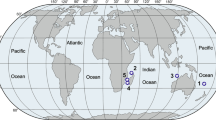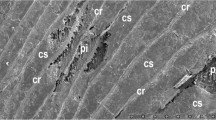Abstract
The deep-sea hydrothermal vent solenogaster Helicoradomenia is covered with calcium carbonate sclerites. Light and electron microscopy reveal varying morphologies of these sclerites. Many sclerites have hollow tips and/or are pitted and etched. Bacteria are found on and in sclerites. Initial sclerite formation occurs in an extracellular crystalline chamber formed by the invagination of a cuboidal basal cell of the columnar microvillus mantle epithelium. As the sclerite grows, it fills the crystalline chamber resulting in direct contact with the microvilli of both the basal cell and neighboring secondary sclerite-forming cells. These cells shape a collar around the base of the growing sclerite. As growth continues, the sclerite-forming cells stretch around the sclerite forming a sheath in which the base of the sclerite resides. Mature sclerites grow through the cuticle into the external environment. The erosion pattern of sclerites reveals a less stable inner medullary region and a harder outer cortical region. This points to a secondary character state, where foremost hollow acicular sclerites develop into solid sclerites. This is in agreement with the systematic position of the genus Helicoradomenia within Simrothiellidae, a taxon typically with hollow sclerites.



Similar content being viewed by others
References
Addadi L, Joester D, Nudelman F, Weiner S (2006) Mollusc shell formation: a source of new concepts for understanding biomineralization processes. Chem Eur J 12:980–987
Blackwelder PL, Watabe N (1977) Studies on shell regeneration. II. The fine structure of normal and regenerated shell of the freshwater snail Pomacea paludosa. Biominer Res Rep 9:1–10
de Paula SM, Silveira M (2009) Studies on molluscan shells: contributions from microscopic and analytical methods. Micron 40:669–690
Dreyer J, Knick KE, Flickinger WB, Van Dover CL (2005) Development of macrofaunal community structure in mussel beds on the northern East Pacific Rise. Mar Ecol Prog Ser 302:121–134
Haas W (1981) Evolution of calcareous hardparts in primitive molluscs. Malacologia 21:403–418
Hoffman S (1949) Studien über das Integument der Solenogastren nebst Bemerkungen über die Verwandtschaft zwischen den Solenogastren und Placophoren. Zoologiska Bidr från Upps 27:293–427
Katz S, Cavanaugh CM, Bright M (2006) Symbiosis of epi- and endocuticular bacteria with Helicoradomenia sp. (Mollusca, Aplacophora, Solenogastres) from deep-sea hydrothermal vents. Mar Ecol Prog Ser 320:89–99
Kingsley RJ (1990) Calcium carbonate spicules in the invertebrates. Chapter 3. In: Carter JG (ed) Skeletal biomineralization: patterns, processes and evolutionary trends, vol I. Van Nostrand Reinhold, New York, pp 27–33
Okusu A (2002) Embryogenesis and development of Epimenia babai (Mollusca: Neomeniomorpha). Biol Bull 203:87–103
Rieger RM, Sterrer W (1975) New spicular skeletons in Turbellaria and the occurrence of sclerites in marine meiofauna. Z Zool Syst Evolut-forsch 13:207–278
Salvini-Plawen LV (1978) Antarktische und subantarktische Solenogastres (eine Monographie: 1898–1974). Zoologica 128:1–305
Salvini-Plawen LV (2008) Three new species of Simrothiellidae (Solenogastres) associated with the hot-vent biotope. J Molluscan Stud 74:223–228
Scheltema AH (2000) Two new hydrothermal vent species, Helicoradomenia bisquama and Helicoradomenia acredema, from the eastern Pacific Ocean (Mollusca, Aplacophora). Argonauta 14:15–25
Scheltema AH (2008) Biogeography, diversity, and evolution through variance of the hydrothermal vent aplacophoran genus Helicoradomenia (Aplacophora, Mollusca). J Shellfish Res 27:91–96
Scheltema AH, Ivanov DL (2002) An aplacophoran postlarva with iterated dorsal groups of sclerites and skeletal similarities to Paleozoic fossils. Invertebr Biol 121:1–10
Scheltema AH, Ivanov DL (2004) Use of birefringence to characterize Aplacophora sclerites. Veliger 47:153–160
Scheltema AH, Kuzirian AM (1991) Helicoradomenia juani gen. et sp. nov., a Pacific hydrothermal vent Aplacophora (Mollusca: Neomeniomorpha). The Veliger 34:195–203
Todt C, Salvini-Plawen LV (2005) The digestive tract of Helicoradomenia (Solenogastres, Mollusca), aplacophoran molluscs from the hydrothermal vents of the East Pacific Rise. Invertebr Biol 124:230–253
Todt C, Okusu A, Schander C, Schwabe E (2008) Solenogastres, Caudofoveata and Polyplacophora. Chapter 4. In: Ponder WF, Lindberg DR (eds) Phylogeny and evolution of the mollusca. University of California Press, Berkeley, pp 71–96
Treves K, Traub W, Weiner S, Addadi L (2003) Aragonite formation in the chiton (Mollusca) girdle. Helv Chim Acta 86:1101–1112
Van Dover CL (2002) Community structure of mussel beds at deep sea hydrothermal vents. Mar Ecol Prog Ser 230:137–158
Weiss IM, Tuross N, Addadi L, Weiner S (2002) Mollusc larval shell formation: amorphous calcium carbonate is a precursor phase for aragonite. J Exp Zool 293:478–491
Acknowledgments
We thank the anonymous reviewers for their detailed and helpful comments. Thank you to undergraduate students Rachel Ruberto and Eric Wong for their contributions to the ultrastructural imaging. Special thanks to Cindy Lee Van Dover for providing us with specimens. This research was funded by University of Richmond Faculty and Undergraduate Research funds.
Author information
Authors and Affiliations
Corresponding author
Additional information
Communicated by T. Bartolomaeus.
Rights and permissions
About this article
Cite this article
Kingsley, R.J., Froelich, J., Marks, C.B. et al. Formation and morphology of epidermal sclerites from a deep-sea hydrothermal vent solenogaster (Helicoradomenia sp., Solenogastres, Mollusca). Zoomorphology 132, 1–9 (2013). https://doi.org/10.1007/s00435-012-0168-x
Received:
Revised:
Accepted:
Published:
Issue Date:
DOI: https://doi.org/10.1007/s00435-012-0168-x




